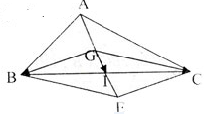Hãy nhập câu hỏi của bạn vào đây, nếu là tài khoản VIP, bạn sẽ được ưu tiên trả lời.

\(\overrightarrow{GA}+\overrightarrow{GB}+\overrightarrow{GC}=\overrightarrow{0}\Rightarrow\left(\overrightarrow{GA}+\overrightarrow{GB}+\overrightarrow{GC}\right)^2=0\)
\(\Rightarrow-2\left(\overrightarrow{GA}.\overrightarrow{GB}+\overrightarrow{GB}.\overrightarrow{GC}+\overrightarrow{GC}.\overrightarrow{GA}\right)=GA^2+GB^2+GC^2\)
\(\Rightarrow\overrightarrow{GA}.\overrightarrow{GB}+\overrightarrow{GB}.\overrightarrow{GC}+\overrightarrow{GC}.\overrightarrow{GA}=-\frac{1}{2}\left(\frac{2}{3}m_a^2+\frac{2}{3}m_b^2+\frac{2}{3}m_c^2\right)\)
\(=-\frac{1}{6}\left(AB^2+BC^2+CA^2\right)\)
Hình như đề bài sai dấu?

Theo tính chất trọng tâm tam giác ta luôn có:
\(\overrightarrow{GA}+\overrightarrow{GB}+\overrightarrow{GC}=\overrightarrow{0}\Rightarrow\overrightarrow{GA}=-\overrightarrow{GB}-\overrightarrow{GC}\)
Thế vào đẳng thức giả thiết ta được:
\(BC.\left(-\overrightarrow{GB}-\overrightarrow{GC}\right)+AC.\overrightarrow{GB}+AB.\overrightarrow{GC}=\overrightarrow{0}\)
\(\Rightarrow\left(AC-BC\right)\overrightarrow{GB}=\left(BC-AB\right)\overrightarrow{GC}\) (1)
Mà \(\overrightarrow{GB};\overrightarrow{GC}\) không phải 2 vecto cùng phương
\(\Rightarrow\left(1\right)\) xảy ra khi và chỉ khi \(\left\{{}\begin{matrix}AC-BC=0\\BC-AB=0\end{matrix}\right.\) \(\Rightarrow\left\{{}\begin{matrix}AC=BC\\AB=BC\end{matrix}\right.\)
\(\Rightarrow AB=AC=BC\) \(\Rightarrow\Delta ABC\) là tam giác đều

\(\overrightarrow{AB}=\overrightarrow{AG}+\overrightarrow{GB}=\overrightarrow{b}-\overrightarrow{a}\)
\(\overrightarrow{GC}=0-\overrightarrow{GA}-\overrightarrow{GB}=-\overrightarrow{a}-\overrightarrow{b}\)
\(\overrightarrow{BC}=\overrightarrow{BG}+\overrightarrow{GC}=-\overrightarrow{b}-\overrightarrow{a}-\overrightarrow{b}=-\overrightarrow{a}-2\overrightarrow{b}\)
\(\overrightarrow{CA}=\overrightarrow{CG}+\overrightarrow{GA}=\overrightarrow{a}+\overrightarrow{b}+\overrightarrow{a}=2\overrightarrow{a}+\overrightarrow{b}\)

\(S=\overrightarrow{GA}.\overrightarrow{GB}+\overrightarrow{GB}.\overrightarrow{GC}+\overrightarrow{GC}.\overrightarrow{GA}\)
\(0=\left(\overrightarrow{GA}+\overrightarrow{GB}+\overrightarrow{GC}\right)^2=GA^2+GB^2+GC^2+2S\Rightarrow S=-\dfrac{GA^2+GB^2+GC^2}{2}\)
\(GA^2+GB^2+GC^2=\dfrac{4}{9}\left(m_a^2+m_b^2+m_c^2\right)\\ =\dfrac{4}{9}\left(\dfrac{2AB^2+2AC^2-BC^2+2BC^2+2AC^2-AB^2+2AB^2+2BC^2-AC^2}{4}\right)\\ =\dfrac{AB^2+AC^2+BC^2}{3}=\dfrac{29}{3}\)
\(\Rightarrow S=-\dfrac{29}{6}\)

a: \(\overrightarrow{BA}-\overrightarrow{BC}=\overrightarrow{BA}+\overrightarrow{CB}=\overrightarrow{CA}\)
b: lấy điểm H sao cho \(\overrightarrow{AH}=\overrightarrow{GC}\)
\(\overrightarrow{AH}=\overrightarrow{GC}\)
=>AH//GC và AH=GC
Xét tứ giác AHCG có
AH//CG
AH=GC
Do đó: AHCG là hình bình hành
ΔABC đều có G là trọng tâm
nên \(AG=GB=GC=\dfrac{a\sqrt{3}}{3}\)
\(\left|\overrightarrow{AB}-\overrightarrow{GC}\right|=\left|\overrightarrow{AB}-\overrightarrow{AH}\right|\)
\(=\left|\overrightarrow{HA}+\overrightarrow{AB}\right|=\left|\overrightarrow{HB}\right|=HB\)
AHCG là hình bình hành
=>HC=AG và HC//AG
=>\(HC=\dfrac{a\sqrt{3}}{3}\)
ΔABC đều có G là trọng tâm
nên GB=GC=GA
GB=GC
AB=AC
Do đó: AG là đường trung trực của BC
=>AG\(\perp\)BC
mà CH//AG
nên CH\(\perp\)CB
=>ΔCHB vuông tại C
=>\(BH^2=HC^2+BC^2\)
=>\(BH^2=\left(\dfrac{a\sqrt{3}}{3}\right)^2+a^2=a^2+\dfrac{1}{3}a^2=\dfrac{4}{3}a^2\)
=>\(BH=a\cdot\dfrac{2\sqrt{3}}{3}\)
=>\(\left|\overrightarrow{AB}-\overrightarrow{GC}\right|=BH=\dfrac{2a\sqrt{3}}{3}\)

Ta đã biết nếu G' là trọng tâm tam giác ABC thì:
\(\overrightarrow{G'A}+\overrightarrow{G'B}+\overrightarrow{G'C}=\overrightarrow{0}\).
Gỉa sử có điểm G thỏa mãn: \(\overrightarrow{GA}+\overrightarrow{GB}+\overrightarrow{GC}=\overrightarrow{0}\).
Ta sẽ chứng minh \(G\equiv G'\).
Thật vậy:
\(\overrightarrow{GA}+\overrightarrow{GB}+\overrightarrow{GC}=\overrightarrow{0}\)
\(\Leftrightarrow3\overrightarrow{GG'}+\overrightarrow{G'A}+\overrightarrow{G'B}+\overrightarrow{G'C}=\overrightarrow{0}\)
\(\Leftrightarrow3\overrightarrow{GG'}=\overrightarrow{0}\)
\(\Leftrightarrow\overrightarrow{GG'}=\overrightarrow{0}\).
Vậy \(G\equiv G'\).

\(T=\overrightarrow{GA}\left(\overrightarrow{BA}+\overrightarrow{AC}\right)+\overrightarrow{GB}.\overrightarrow{CA}+\overrightarrow{GC}.\overrightarrow{AB}\)
\(=\overrightarrow{AB}\left(\overrightarrow{GC}-\overrightarrow{GA}\right)+\overrightarrow{AC}\left(\overrightarrow{GA}-\overrightarrow{GB}\right)\)
\(=\overrightarrow{AB}\left(\overrightarrow{GC}+\overrightarrow{AG}\right)+\overrightarrow{AC}\left(\overrightarrow{GA}+\overrightarrow{BG}\right)\)
\(=\overrightarrow{AB}.\overrightarrow{AC}+\overrightarrow{AC}.\overrightarrow{BA}\)
\(=0\)